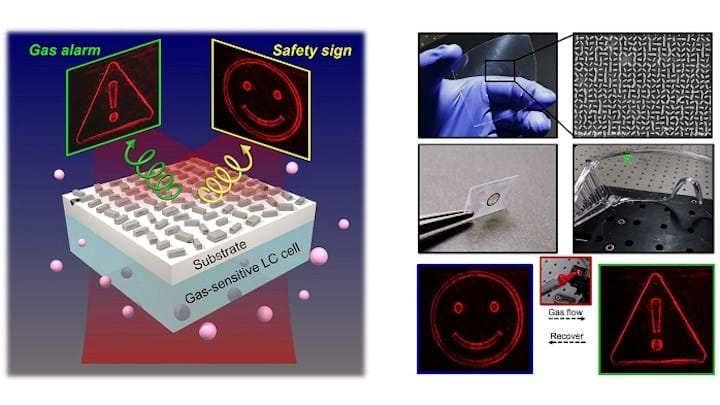Novel wearable gas sensor
RESEARCHERS at the Pohang University of Science and Technology (POSTECH), South Korea have developed a wearable sensor that can detect volatile gases and immediately notify users through a holographic image. The inexpensive, ultracompact device could help avoid gas accidents.
Gas accidents such as toxic gas leaks in factories, toxic gas suffocation during manhole cleaning, or carbon monoxide releases from boilers, can claim lives and cause injury. In hazardous environments such as petrochemical plants, gas sensors are vital.
However, conventional gas sensors are not widely used, as they are made with complex machinery and electronic devices (and are therefore expensive), are difficult to use, and have poor portability and reaction speed.
The device developed at POSTECH can respond quickly in the presence of gases, via a visual holographic alarm. It employs a metasurface and liquid crystals (LCs). Metasurfaces are artificial nanostructured interfaces that can manipulate light. In this way, they can transmit two-way holograms or three-dimensional (3D) video images.
Inki Kim, Postdoctoral Fellow in the Department of Mechanical Engineering at POSTECH, explained that the holographic device consists of tiny nanobar structures – the LCs – which are rotated to produce a particular holographic image. The metasurfaces can show one of two different images depending on whether they interact with light that is left-circularly polarised (LCP) or right-circularly polarised (RCP). This describes whether light travelling from the source rotates clockwise (LCP) or counterclockwise (RCP).

The devices additionally use a gas sensitive LC cell that responds to the presence of a target gas. If the target gas is not present, the modulator transmits RCP light and a holographic smiley face is projected, representing the “safety sign”. If the target gas is present, LCP light is transmitted and an exclamation mark is rendered, acting as a visual alarm.
Researchers discovered in experiments, using isopropyl alcohol (IPA) as the target gas, that the image changed in about 18 seconds at a concentration of 200 ppm and in around 7 seconds at 400 ppm. IPA, typically used as a cleaning solution in the industry, is a known toxic substance that can cause stomach pain, headaches, dizziness, confusion, slow breathing, and it is even suspected to be one of the main causes of leukaemia in the semiconductor industry. The US Occupational Safety and Health Administration (OSHA) has set the current permissible exposure to IPA at 400 ppm averaged over an eight-hour shift.
After exposure to gas, the “safety” image can be rapidly restored by removing that gas. However, the devices can also be designed so that the LC cell remains stable in the “alarm” state even after the gas is removed through polymer network formation, which is the technique currently adopted in LC-based electronic papers. In this way, the sensor could be used in applications where exposure of a harmful gas needs to be tracked, such as in the transportation and storage of gas-sensitive products.
Further proving applicability, the POSTECH team demonstrated that the sensor could be integrated onto safety goggles via a one-step nanocasting process used to produce a flexible and wearable device. The simple method is suitable for use in mass manufacturing.
To demonstrate this, the researchers created a titanium dioxide (TiO2) nanoparticle resin composite (NPC) metasurface, by spin-coating TiO2 nanoparticle resin onto a polymer mould. Ultraviolet (UV) light and pressure is applied to polymerise the monomers in the TiO2 NPC. Once cured, the mould is placed NPC-side down onto flexible polyethylene terephthalate (PET) substrate and the mould is removed, leaving the NPC in place as it more strongly adheres to the PET than the mould. The flexible and conformal holographic sensor – printed onto flexible PET film – can then be attached to the curved surface of safety glasses.
To enable commercial use, the researchers are currently working to ensure that the sensor can respond selectively to a gas, and to allow the device to respond to a specific concentration of the target gas.
In future, the researchers aim to create high-performance environmental sensors that could display the type and concentration of gases or biochemicals in the surroundings with a holographic alarm. They are studying optical design techniques that can encode various images.
Kim said: “We think that our approach can be a straightforward method of visual sensors…Depending on the LC functionalisation, diverse substance like bacteria, viruses or heavy metals can be detected, providing holographic alarm signal.”
The sensor could be used to benefit areas such as public health, environmental monitoring, and military sectors, in which rapid detection of toxic gases or biochemicals is an important issue.
The team anticipates that it could be integrated into glass-type augmented reality display systems under development by Apple, Facebook, Google, and Samsung.
Science Advances: https://doi.org/gjpkhf
Recent Editions
Catch up on the latest news, views and jobs from The Chemical Engineer. Below are the four latest issues. View a wider selection of the archive from within the Magazine section of this site.




